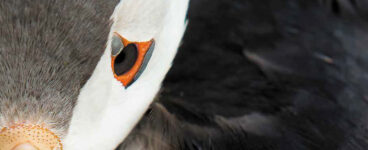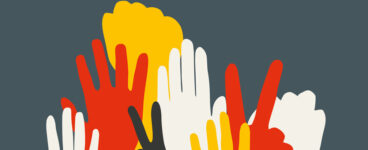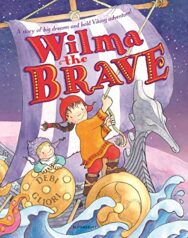Somewhere, in the back of my mind, a story began to form. A story of a girl who didn’t just want to make soup and mend torn clothing and babysit. A girl who wanted to have adventures and slay monsters.
Wilma belongs to a fearsome family of Viking warriors, and she has big plans. Her older brothers all laugh, telling her that real adventurers are just for boys, but she’s set to prove them all wrong. Debi Gliori speaks to Books from Scotland about her newest release, and others she’s keen to recommend in our feature ‘The Book’.
Wilma the Brave
By Debi Gliori
Published by Bloomsbury
The book as . . . memory. What is your first memory of books and reading?
I can still remember sitting in my cot, abandoned with a pile of picture books and an admonition to be good until my parents returned from church. This happened every Sunday morning until I was old enough to experience my parents’ chosen brand of ecclesiastical boredom for myself. The fact that I was only three and quite unable to read didn’t put me off; the pictures and the memory of having had the stories read to me carried me happily through these mornings that were, in retrospect, totally illegal. Whatever were my parents thinking of? God, I suppose…
A favourite of these solitary mornings was ‘Kingcup Cottage’, published by Medici in paperback, illustrated by Racey Helps ( fabulous name, redolent of the 1930’s) which was a heartrending tale of Francesca, a frog who threw herself a birthday party, baked cakes and jellies, sent out invitations to all her woodland friends and then sat…and sat…and sat, waiting for her guests to arrive. Poor sad Francesca, waiting under a picture of herself as a baby tadpole on a furry rug ( I loved this detail as a toddler and still do) waiting as her jellies deliquesced and her jaunty party hat slumped and she was forced to admit that nobody was coming. I drank in the illustrations, poring over the details, loving when I unlocked another unwritten visual clue that leavened and expanded the words I was too young to decode. So much did I love this book that I hunted it down as an adult and was transported back through time into its gentle world as if I’d discovered my very own time machine.
The book as . . . your work. Tell us about your latest book Wilma the Brave. What did you want to explore in writing this book?
Reading accounts of Viking and their lives, I was struck by how much of the historical focus was centred around the deeds of the men. This impression was deepened by spending six weeks as writer-in-residence in Shetland, where I was regaled with stories of Up Helly ‘A, a night when women would wait in the many village halls dotted round the islands, preparing pots of soup and cakes and beer to greet the almost exclusively male Yarl Squad as it caroused from hall to hall, brandishing flaming torches and burning galleys and wearing fabulous furry waistcoats, horned helmets, swords and shields and every appurtenance of historical cosplay.
And the women got to serve soup.
Somewhere, in the back of my mind, a story began to form. A story of a girl who didn’t just want to make soup and mend torn clothing and babysit. A girl who wanted to have adventures, slay monsters and sail to the four corners of the Earth. I wanted to write about a girl who confounded expectations, had the heart of a lion but was at the same time, a devoted big sister to the small Harald. And Harald, raised on tales of male derring-do, wanted nothing more than to stay home, make soup, knit warm things and in his small and quiet fashion, confound expectations just like his big sister, Wilma.
The book as . . . inspiration. What is your favourite book that has informed how you see yourself?
Without a doubt, this has to be Tove Jansson’s Comet in Moominland. In its pages, I realised that far from being a brave, adventuring Wilma, or Snufkin, I was in fact a cross between the fluffy vanity of the Snork Maiden and the daydreaming practicality of Moominmamma. I stumbled across Comet as a desperately confused and damaged ten year old, and immediately felt I’d come home. Safe at last, even as a comet hurtled towards Earth.
The book as . . . an object. What is your favourite beautiful book?
I have a very precious ( to me) copy of Hans Christian Andersen’s fairy tales illustrated by the Czechoslovakian artist, Jiri Trnka. On the front boards is one of HCA’s papercuts, embossed in gold, of the little dancing princess from the music box in the story of the Little Fir Tree. The illustrations have a dreamlike softness and timeless beauty that lodged them in my subconscious as a child, and I still take the book off my studio shelves and immerse myself in the exquisite colour plates inside.
The book as . . . a relationship. What is your favourite book that bonded you to someone else?
Interesting question, this. In attempting to answer, I find that I am doomed to remain unbonded by a shared experience of reading. Books I press upon loved ones tend to slide off unread or unremarked ; conversely, books recommended to me with huge enthusiasm by persons close to me tend to make me feel under an obligation to read but ultimately wonder why on earth I’m doing so. I enter into a relationship with the story, I am bonded to the characters in a relationship of discovery ; finding points of commonality, discovering facets of myself in the characters in the book and wishing that I could meet them in real life.
The book as . . . rebellion. What is your favourite book that felt like it revealed a secret truth to you?
Marilyn French’s The Women’s Room. In the death throes of a relationship, this book gave me the language to accurately pinpoint why I needed to leave. It gave me courage and helped me trust myself and my feelings. This was a very long time ago, and I probably will not re-read it, but remain forever grateful to Ms French for populating my head ( albeit temporarily) with exactly the kind of women I needed to surround myself with at the time.
The book as . . . a destination. What is your favourite book set in a place unknown to you?
Apsley Cherry-Garrard’s The Worst Journey In the World. Lacking the requisite funds to travel to Antarctica, I rely on reading the accounts of others who have been there. Of the many books written on the subject of the South Pole, this for me is the definitive work. Harrowing, beautiful, elegiac, it is an astonishing feat of literature and unquenchable humanity.
The book as . . . the future. What are you looking forward to reading next?
Currently, I am reading less and listening to audiobooks more. This appears to be a by-product of the strange times we lived through while under the Covid cosh, where books and stories helped to drown out ( for me) the ever-present shrieking anxieties about our uncertain future.
To be honest, two years on, little has changed. Our lives are still awash in massive uncertainties, the world and its woes conspire to unsettle and alarm me every time I am foolish enough to engage with the news cycle and sometimes an audiobook is the only thing that will hold my attention for long enough to allow my shoulders to drop down from their permanent position of being hunched beside my ears. Also, using my ageing eyeballs to do my daytime job as an illustrator tends to mean that by night-time, the prospect of focussing on small print holds little appeal. An audiobook is the perfect compromise ; I can complete some of the myriad domestic tasks requiring my attention while a mellifluous stranger reads me a book at bedtime. I look forward to the next immersive story ; being read to is, for me, utter bliss.
Wilma the Brave by Debi Gliori is published by Bloomsbury, priced £12.99.
ALSO IN THIS ISSUE

 Puffins
Puffins
My first tentative steps into wildlife photography came from visiting a local pond and taking photog …

 Never Did The Fire
Never Did The Fire
‘We write books to explain what has happened to us, and it is impossible to translate that experienc …













